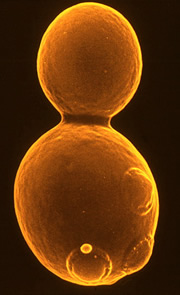You found Simon

Direct link to this page: https://www.hayadan.org.il/prionsevo.html
Prions, the distorted proteins usually linked to disease (by the mad cow, editor of the site, AB), can help organisms adapt to harsh environmental conditions, by slightly changing the proteins produced by the cell. The finding supports the idea that proteins, as well as DNA, are essential in driving evolution.
Prions are proteins that bind in one of two forms. In mammals, one form of prion is not harmful at all, and functions normally, while the other form of the same protein is infectious and causes injury. It is assumed that the basis for mad cow disease and the human disease equivalent to it, Creutzfeldt-Jakob disease, is prions.
But scientists studying the yeast Scromeiceus cerevisiae found that, in some cases, infectious prions may play an important role. In colonies of yeast cells, some cells carry the "normal" type of protein, while others store the infectious type, which aggregates into clumps and is passed from one cell to another.
Four years ago, Susan Lindquist and Heather Therow of the Whitehead Institute in Massachusetts showed that such yeast prion can change the way cells behave. In their infectious form, the prions helped the yeast to adapt, and affected the survival rate of the yeast that were grown on a variety of nutrients or temperatures. That is, the presence of the prions helped the cells in any way to adapt to changing (even harsh) conditions of the environment.
Now Lindquist and her colleagues have deciphered how prions do this. In its "normal" form, the protein helps to read and convert the genetic code into other proteins. But in its contagious form, the fruit stops functioning. This means that the production of many other proteins becomes a little more sloppy.
An evolutionary shortcut
The scientists therefore believe that the prions offer an accelerated way for the yeast to develop, because those cells with the infectious prion produce a wide range of proteins that are slightly different from normal. Usually such sloppy proteins are a problem because they do not function under normal conditions as efficiently as the normal proteins. However, in situations where there is a change (sometimes extreme) in the environmental conditions, this new variety of proteins, slightly different from the usual proteins, constitutes an effective pool of proteins better adapted to the new conditions. Those cells in which the infectious prions caused the creation of sloppy proteins that adapt to the changing environment, constitute a survival advantage for the cell itself and for the entire yeast colony.
This mechanism may be important in helping the yeast survive for short periods of time, Thero says. This gives the cells time to improve genetically by accumulating genetic changes necessary for survival in the new conditions. These genetic changes are passed on to future generations.
The mechanism of the sloppy proteins is not genetic, and is based on the production of proteins under less stringent conditions, due to the paralysis of one of the proteins that take part in the translation process. The paralysis of the protein (in the form of an infectious prion event) allows the creation of a variety of proteins with a structure similar, but not exact to the "normal" proteins. The difference in the sloppy proteins allows a better adaptation to the changed conditions, but the change is neither hereditary nor permanent. This is a temporary change, which is a sort of transitional phase, until the genetic changes occur and allow a permanent change in the structure and properties of the proteins.
The research findings contradict the general assumption in evolution, which claims that when organisms adapt to a change in their environment, they do so by acquiring random mutations in their DNA.
"I think this whole new approach is very important," says molecular biologist Michael Schneider of Yale University in New Haven, Connecticut. Other proteins in different organisms may act in a similar way, Schneider suggests, by slightly changing the form or amount of the proteins that are formed. "It is not clear to us at the moment how widespread this phenomenon is," he says.
The article is adapted from an article in Nature News:
For information in Nature
They know evolution in action
https://www.hayadan.org.il/BuildaGate4/general2/data_card.php?Cat=~~~933681498~~~37&SiteName=hayadan
